
The Noctuidae, commonly known as owlet moths, cutworms or armyworms, are the most controversial family in the superfamily Noctuoidea because many of the clades are constantly changing, along with the other families of the Noctuoidea. It was considered the largest family in Lepidoptera for a long time, but after regrouping Lymantriinae, Catocalinae and Calpinae within the family Erebidae, the latter holds this title now. Currently, Noctuidae is the second largest family in Noctuoidea, with about 1,089 genera and 11,772 species. However, this classification is still contingent, as more changes continue to appear between Noctuidae and Erebidae.

Noctuoidea is the superfamily of noctuid or "owlet" moths, and has more than 70,000 described species, the largest number of for any Lepidopteran superfamily. Its classification has not yet reached a satisfactory or stable state. Since the end of the 20th century, increasing availability of molecular phylogenetic data for this hugely successful radiation has led to several competing proposals for a taxonomic arrangement that correctly represents the relationships between the major lineages.

The Calpinae are a subfamily of moths in the family Erebidae described by Jean Baptiste Boisduval in 1840. This subfamily includes many species of moths that have a pointed and barbed proboscis adapted to piercing the skins of fruit to feed on juice, and in the case of the several Calyptra species of vampire moths, to piercing the skins of mammals to feed on blood. The subfamily contains some large moths with wingspans longer than 5 cm (2 in).
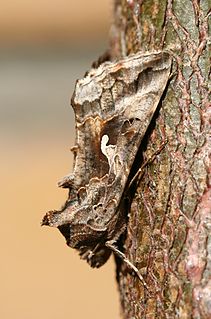
Plusiinae is a smallish subfamily of the moth family Noctuidae. As the Noctuidae appear to be a paraphyletic assemblage, the Plusiinae may eventually be raised to family status.
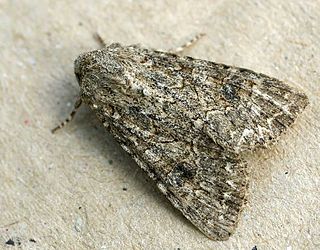
Hadeninae is a subfamily of moth family Noctuidae. The limits between this group and the Condicinae and Noctuinae are still not precisely known, with 3 major and partially conflicting revisions since 2006. Some include the noctuid subfamilies Eriopinae and Psaphidinae here as tribes Eriopini and Psaphidini, yet the former are not even recognized as distinct tribe by all sources. Another proposed treatment is to include the group within an expanded Noctuidae.

Acronictinae is a large subfamily of moths in the family Noctuidae.

Cryphia is a genus of moths of the family Noctuidae. The genus was erected by Jacob Hübner in 1818.
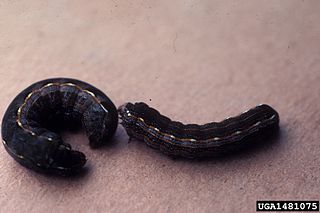
Spodoptera latifascia, commonly known as the lateral-lined armyworm, garden armyworm, or velvet armyworm, is a moth of the family Noctuidae found from Central America and the Antilles into North America. Previously S. cosmioides, was treated as a synonym S. latifascia however it was restored as a valid species in Pogue (2002).
Calocucullia celsiae is a moth of the family Noctuidae. The species was first described by Gottlieb August Wilhelm Herrich-Schäffer in 1850. It is found from the Balkans to Turkey, northern Iraq, Armenia, Iran, Israel, Jordan and Lebanon.
Cleonymia opposita is a moth of the family Noctuidae first described by Julius Lederer in 1870. It is widespread in Asia Minor, expanding northwards to the Armenian-Caucasian Region, eastward to Iraq.
Omphalophana anatolica is a moth of the family Noctuidae first described by Julius Lederer in 1857. It is found in south-eastern Europe, the Near East and Middle East.
Metopoceras kneuckeri is a moth of the family Noctuidae first described by Hans Rebel in 1903. It is found from northwest Africa to Pakistan.
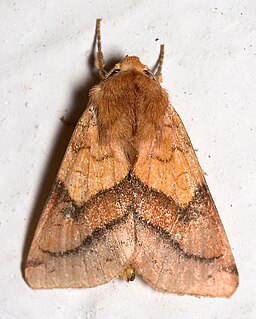
Pyrrhia exprimens, the purple-lined sallow, is a moth of the family Noctuidae. The species was first described by Francis Walker (entomologist) in 1857. In North America it is found from Newfoundland and Labrador west across southern Canada to southern Vancouver Island, south to Texas, Arizona and California. Outside of North America it is found in Finland, the West Siberian plain, the South Siberian Mountains and Kazakhstan.

Heliothinae is a small subfamily of moths in the family Noctuidae. There are about 400 species described worldwide. They are found more commonly found in partially dry areas of subtropical habitats.

The Erebidae are a family of moths in the superfamily Noctuoidea. The family is among the largest families of moths by species count and contains a wide variety of well-known macromoth groups. The family includes the underwings (Catocala); litter moths (Herminiinae); tiger, lichen, and wasp moths (Arctiinae); tussock moths (Lymantriinae), including the arctic woolly bear moth ; piercing moths ; micronoctuoid moths (Micronoctuini); snout moths (Hypeninae); and zales, though many of these common names can also refer to moths outside the Erebidae. Some of the erebid moths are called owlets.

The Erebinae are a subfamily of moths in the family Erebidae erected by William Elford Leach in 1815. Erebine moths are found on all continents except Antarctica, but reach their greatest diversity in the tropics. While the exact number of species belonging to the Erebinae is not known, the subfamily is estimated to include around 10,000 species. Some well-known Erebinae include underwing moths (Catocala) and witch moths (Thermesiini). Many of the species in the subfamily have medium to large wingspans, up to nearly 30 cm in the white witch moth, which has the widest wingspan of all Lepidoptera. Erebine caterpillars feed on a broad range of plants; many species feed on grasses and legumes, and a few are pests of castor bean, sugarcane, rice, as well as pistachios and blackberries.
Max Gaede was a German engineer and entomologist of international fame who described several hundred of new species of Lepidoptera, mainly African Noctuidae.
Emilio Berio was an Italian entomologist and lawyer.
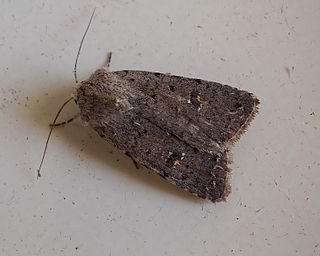
Caradrina flavirena is a moth of the family Noctuidae. It was described by Achille Guenée in 1852. It is found in Morocco, Algeria, southern Europe, Turkey, Israel, Lebanon, Jordan, Syria, Armenia and Iran. The habitat consists of grasslands.
James Clark Molesworth Gardner was a British entomologist who worked on the systematics of insects, particularly forest insects, while employed in the Indian Forest Service at the Forest Research Institute, Dehra Dun in India.












